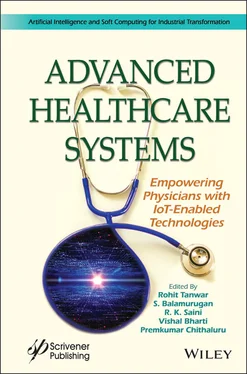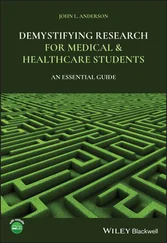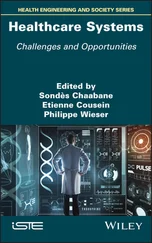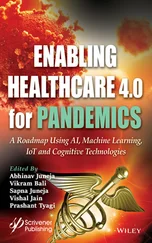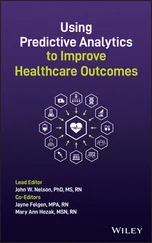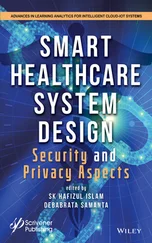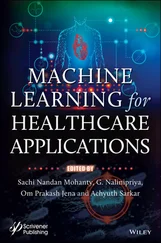Advanced Healthcare Systems
Здесь есть возможность читать онлайн «Advanced Healthcare Systems» — ознакомительный отрывок электронной книги совершенно бесплатно, а после прочтения отрывка купить полную версию. В некоторых случаях можно слушать аудио, скачать через торрент в формате fb2 и присутствует краткое содержание. Жанр: unrecognised, на английском языке. Описание произведения, (предисловие) а так же отзывы посетителей доступны на портале библиотеки ЛибКат.
- Название:Advanced Healthcare Systems
- Автор:
- Жанр:
- Год:неизвестен
- ISBN:нет данных
- Рейтинг книги:5 / 5. Голосов: 1
-
Избранное:Добавить в избранное
- Отзывы:
-
Ваша оценка:
- 100
- 1
- 2
- 3
- 4
- 5
Advanced Healthcare Systems: краткое содержание, описание и аннотация
Предлагаем к чтению аннотацию, описание, краткое содержание или предисловие (зависит от того, что написал сам автор книги «Advanced Healthcare Systems»). Если вы не нашли необходимую информацию о книге — напишите в комментариях, мы постараемся отыскать её.
This book offers a complete package involving the incubation of machine learning, AI, and IoT in healthcare that is beneficial for researchers, healthcare professionals, scientists, and technologists.
Audience
Advanced Healthcare Systems — читать онлайн ознакомительный отрывок
Ниже представлен текст книги, разбитый по страницам. Система сохранения места последней прочитанной страницы, позволяет с удобством читать онлайн бесплатно книгу «Advanced Healthcare Systems», без необходимости каждый раз заново искать на чём Вы остановились. Поставьте закладку, и сможете в любой момент перейти на страницу, на которой закончили чтение.
Интервал:
Закладка:
• In Chapter 1, “Internet of Medical Things – State of the Art,” Dr. Kishor Joshi and Dr. Ruchi Mehrotra present the latest technological advancements in the on-body segment of consumer health wearables. Since the traditional approach in healthcare is a more personalized touch-based system, it is not replaceable for diagnosis. Older, chronically ill patients need remote monitoring and medial management services that ensure that nurses or local healthcare assistants connect to doctors in urban or super-specialty fields for better services. This chapter indicates there is already a steep rise in internet of medical things (IoMT) products, but there is still huge potential for growth in the IoMT industry.
• In Chapter 2, “Issues and Challenges Related to Privacy and Security in Healthcare Using IoT, Fog and Cloud Computing” Hritu Raj, Mohit Kumar, Prashant Kumar, Amritpal Singh and Om Prakash Verma describe the complete architecture along with various challenges and security risks of the next generation healthcare industry with healthcare IoT sensor and fog computing. Furthermore, some methodologies used in various research papers are presented that address security and privacy-related issues in the IoT, Fog and Cloud computing environment.
• In Chapter 3, “Study of Thyroid Disease Diagnosis Using Machine Learning Technique,” Shanu Verma, Dr. Rashmi Popli and Dr. Harish Kumar discuss Graves’ disease, the most common cause of hypothyroidism that is associated with eye disease. Thyroid cancer, which infects the gland at the base of the neck, has been increasing over the past few years. Endocrinologists believe that this is because the use of new technology, i.e., machine learning, has allowed the detection of thyroid cancer that may not have been detected in the past. According to the Cancer Registry, thyroid cancer is the second more common cancer among women, occurring 3 times more often in women than in men. This chapter studies thyroid disease using a machine learning algorithm.
• In Chapter 4, “A Review of Various Security and Privacy Innovations for IoT Applications in Healthcare,” Mr. Abhishek Raghuvanshi, Dr. Umesh Kumar Singh and Mr. Chirag Joshi focus on the analysis of numerous security and privacy technologies in healthcare, intelligent communities and smart homes available for IoT applications. According to the findings of an industrial internet survey by the World Economic Forum, roughly two-thirds of respondents said the main issue was interoperability and protection. Most IoT apps are web applications and all of them still have denial-of-service and man-in-the-middle attacks as major threats to the security of their healthcare, smart city, smart home and other IoT applications.
• In Chapter 5, “Methods of Lung Segmentation Based on CT Images,” Amit Verma and Thipendra P. Singh focus on the use of CT scan images for analysis of lung airways, lung parenchyma, and breathing mechanisms. For better diagnosis of any lung problems, the automatic, nearly accurate analysis of CT images is better than the manual method of doctors analyzing CT scans. In this chapter, automatic and semi-automatic methods of segmentation of lung CT images are discussed.
• In Chapter 6, “Handling Unbalanced Data in Clinical Images,” Amit Verma focuses on various data-level and algorithm-level-based approaches developed to balance imbalanced data for improving the accuracy of the trained model. In this chapter, the concept and problem of imbalanced data is discussed and various approaches for balancing the data are also highlighted, in which one of the state-of-the-art methods called bagging is discussed in detail.
• In Chapter 7, “IoT-Based Health Monitoring System for Speech Impaired People Using Assistive Wearable Accelerometer,” Dr. Madhumathy P., Ishita Banerjee and Digvijay Pandey describe IoT-based wireless communication systems with network devices connected to each other that communicate through open source internet access and establish connection between apps and devices for communication between the person being supervised and the medical supervisor. This system can also keep track of real-time records and emergency alerts. To handle the storage and analysis of data-related issues, IoT analytics is implemented.
• In Chapter 8, “Smart IoT Devices for the Elderly and People with Disabilities,” K. N. D. Saile and Kolisetti Navatha focus on the huge changes brought about by the IoT-powered revolution in health management devices for the elderly and disabled like sensors, wearable devices, audio and video assistance, etc. All these are possible with the help of the IoT. In this chapter, we discuss the technology trends in devices made during the IoT era.
• In Chapter 9, “IoT-Based Health Monitoring and Tracking System for Soldiers,” Dr. Madhumathy P., Kavitha N and Digvijay Pandey discuss smart sensors used in the medical treatment of soldiers. By tracking a soldier’s location on the battlefield with a smart sensor attached to their body, more accurate body status information can be provided to medical units in order to offer more immediate care. These systems are designed to be implemented for complete mobility with a personal server, which in turn would give a message to the server base station through wireless mode. Soldiers are able to be identified at the earliest based on their unique IP address.
• In Chapter 10, “Cloud-IoT Secured Prediction System for Processing and Analysis of Healthcare Data Using Machine Learning Techniques,” Dr. G. K. Kamalam, and Ms. S. Anitha discuss a cloud-IoT secured prediction system designed to improve healthcare performance by reducing the execution time of a patient’s request, optimizing the desired selection of the massive amount of patient’s facts and imparting a records retrieval process for those applications. Analysis of the experimental results show that the presented method performs better than existing benchmark systems for considering parameters like disease prediction accuracy, sensitivity, specificity, F-measure, and computational time.
• In Chapter 11, “Cloud-IoT-Driven Healthcare: Review, Architecture, Security Implications and Open Research Issues,” Junaid Latief Shah, Heena Farooq Bhat and Asif Iqbal Khan discuss security loopholes inherent in IoT architecture and the Cloud platform. The chapter also elaborates on various security countermeasures that have been proposed in the literature, highlighting their strengths and limitations. Also, a discussion on possible defense measures has been provided. The chapter culminates in underlining some burning research problems and security issues that need to be addressed for seamless healthcare services.
• In Chapter 12, “A Novel Usage of Artificial Intelligence and Internet of Things in Remote-Based Healthcare Applications,” Dr. V. Arulkumar, D. Mansoor Hussain, S. Sridhar, and Dr. P. Vivekananda present the information necessary to reap the benefits of research capacity solutions through AI techniques. Healthcare services are among the applications enabled by the IoT. Advanced sensors may be used to monitor the health of permanent patients or may be inserted into the bodies of patients that can analyze, combine and prioritize the information gathered. Working with algorithms helps doctors change treatments and, at the same time, helps to economize on healthcare.
• In Chapter 13, “Use of Machine Learning in Healthcare,” V. Lakshman Narayana, R. S. M. Lakshmi Patibandla, B. Tarakeswara Rao and Arepalli Peda Gopi focus on AI-assisted healthcare. Quotient Health has developed a program designed to reduce the cost of EMR structures by strengthening and standardizing the structuring of these frames. This chapter discusses healthcare AI, various implementations of AI, certifiable healthcare benefits, the morality of AI computations and opportunities to improve quality of healthcare skills.
Читать дальшеИнтервал:
Закладка:
Похожие книги на «Advanced Healthcare Systems»
Представляем Вашему вниманию похожие книги на «Advanced Healthcare Systems» списком для выбора. Мы отобрали схожую по названию и смыслу литературу в надежде предоставить читателям больше вариантов отыскать новые, интересные, ещё непрочитанные произведения.
Обсуждение, отзывы о книге «Advanced Healthcare Systems» и просто собственные мнения читателей. Оставьте ваши комментарии, напишите, что Вы думаете о произведении, его смысле или главных героях. Укажите что конкретно понравилось, а что нет, и почему Вы так считаете.
